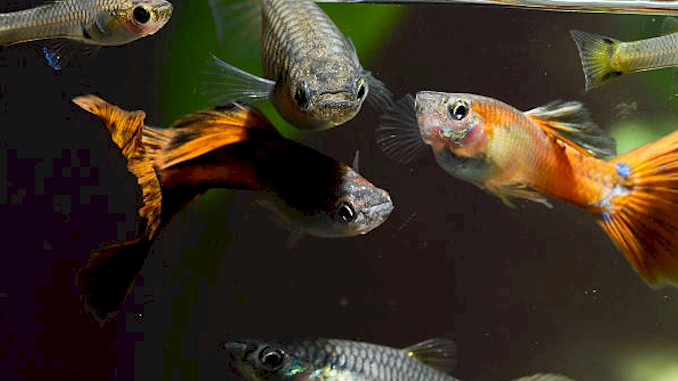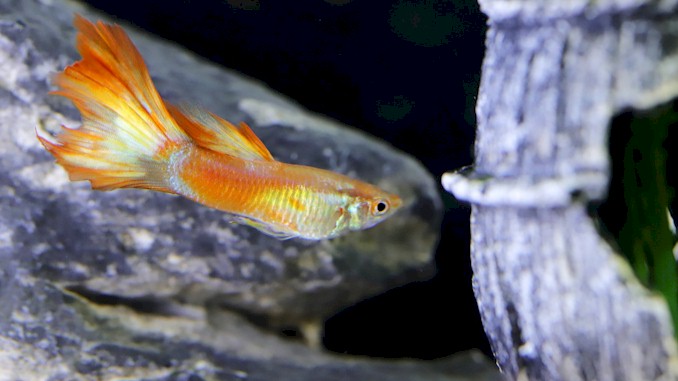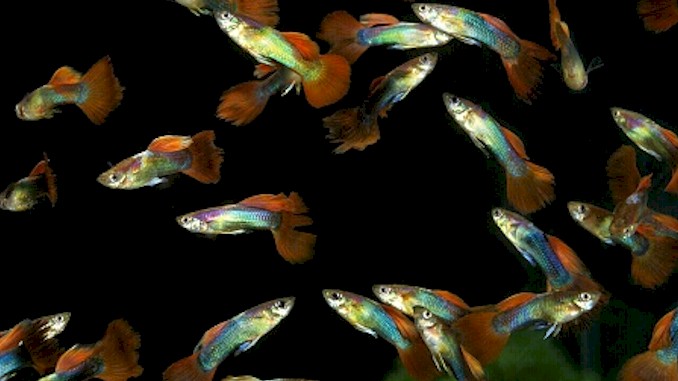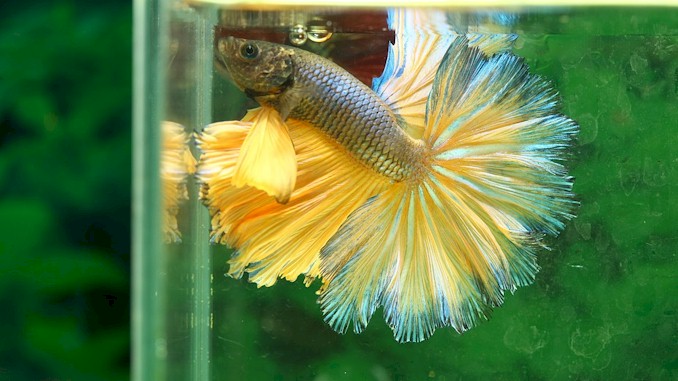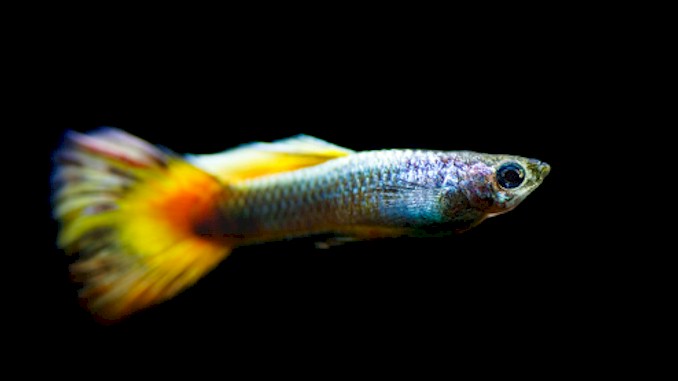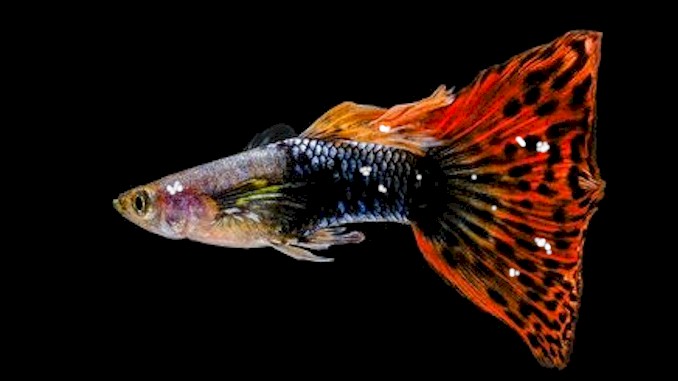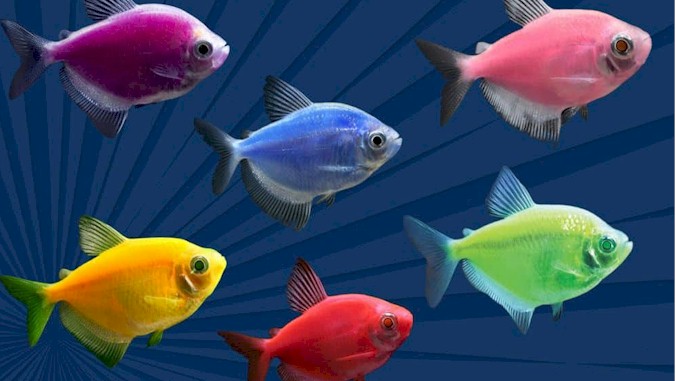Guppy Bubble Blowing: What You Need to Know
If you have guppies in your aquarium, you may have noticed that they sometimes blow bubbles at the top of the water. You may wonder why they do this and whether it is a sign of a problem. In this blog post, I will explain why guppies blow bubbles and what you can do to prevent it.
Guppies blow bubbles mainly because of low oxygen levels in the water. This can happen if your tank is overcrowded, overstocked with plants, or has poor water quality. When guppies can’t breathe properly, they try to get more oxygen by breathing faster and releasing bubbles as a result. Bubbles can also be caused by ammonia spikes that irritate their gills.
Blowing bubbles is not normal for guppies and can indicate that they are stressed or sick. If you see your guppies blowing bubbles frequently, you should take action to improve their living conditions. In this blog post, I will share with you reasons why guppies blow bubbles and solutions to stop your guppies from blowing bubbles and keep them healthy and happy.
Why is my guppy fish blowing bubbles?
If you’ve noticed your guppy fish blowing bubbles in your tank, you may be wondering why this behavior is occurring. There are a few reasons why guppy fish may be blowing bubbles, and understanding these reasons is important in ensuring the health and well-being of your fish.
The reason why guppy fish may be blowing bubbles is due to the oxygen level in your tank. Guppies, like all fish, require oxygen to survive, and if the oxygen level in your tank is low, they may begin to blow bubbles to increase the oxygen level in their immediate area. This behavior is a sign that the oxygen level in your tank may be too low, and you should take action to increase it.
If you notice that your guppies are blowing bubbles excessively or continuously, it may be a sign of stress or illness. In this case, it’s important to monitor their behavior and take steps to address any underlying health issues.
But how do you know if your tank has enough oxygen for your guppies? And what are the factors that affect the oxygen level in your tank? In this section, I will answer these questions and give you some tips on how to measure and maintain a healthy oxygen level for your guppies.
How to Measure the Oxygen Level in Your Tank
One way to tell if your tank has enough oxygen is by observing your guppies’ behavior. If your fish appear active and happy, and none are gulping air from the surface, your tank’s oxygen level is sufficient. However, this method is not very accurate or reliable.
If you would like to measure the exact parts-per-million (ppm) of dissolved oxygen in your aquarium, purchase a portable dissolved oxygen meter. This device will give you a precise reading of how much oxygen is available in your water. A generally safe oxygen level for all freshwater fish is 8.3 ppm.
Another option is to use an oxygen test kit that uses chemical reagents to measure the dissolved oxygen concentration. These kits are cheaper than meters but less accurate and more time-consuming.
What Affects the Oxygen Level in Your Tank
Several factors can affect the oxygen level in your tank. Some of them are:
- Water temperature: Cold water holds more dissolved oxygen than warm water. So if the water in your tank is on the warmer side, the oxygen level will be lower. However, you need to keep in mind that guppies prefer warm water between 72°F and 82°F4.
- Water movement: Water movement helps to circulate the water and increase gas exchange at the surface. This means more oxygen can enter the water from the air. Water movement can be created by filters, powerheads, air pumps, or bubblers.
- Water quality: Poor water quality can lower the oxygen level in your tank by increasing organic waste and ammonia levels. These substances consume oxygen during decomposition and also irritate your guppies’ gills. You should perform regular water changes and use a good filter system to keep your water clean and clear.
- Tank size: The size of your tank determines how much water volume and surface area you have available for gas exchange. A larger tank with more surface area can hold more dissolved oxygen than a smaller tank with less surface area. You should avoid overstocking or overcrowding your tank with too many fish or plants.
- Plants: Live plants can produce oxygen during photosynthesis but consume it during respiration. This means that plants can increase or decrease the oxygen level depending on whether it is day or night. You should balance the number of plants with other sources of aeration such as filters or air pumps.
Now that you know what affects the oxygen level in your tank, let’s see how you can increase it if it is too low for your guppies.
How to Increase the Oxygen Level in Your Tank
One of the main reasons why guppies blow bubbles is because they do not have enough oxygen in their tank. Oxygen is essential for guppies to breathe and survive. Without enough oxygen, guppies will become stressed, sick, and eventually die.
But how can you increase the oxygen level in your tank and prevent your guppies from blowing bubbles? There are several ways to do that, depending on your situation and preference. Here are some of the most effective methods:
- Water change: One of the simplest ways to increase dissolved oxygen levels in your tank is simply by doing regular water changes. When you change out old water for fresh water, you are automatically increasing the amount of oxygen in the tank since fresh water has a higher concentration than old water. You should change about 25% of your water every week using a gravel vacuum or siphon. You should also use dechlorinated tap water or bottled spring water that matches the temperature and pH of your tank water.
- Water movement: Water movement helps to circulate the water and increase gas exchange at the surface. This means more oxygen can enter the water from the air. Water movement can be created by filters, powerheads, air pumps, or bubblers. You should choose a device that is appropriate for your tank size and has a gentle flow rate that does not stress your guppies. You should also adjust the device so that it creates enough surface agitation but not too much turbulence or noise.
- Air pump or bubbler: An air pump or bubbler can supplement the oxygen level in your tank by creating bubbles that agitate the water surface. You should use an air stone or diffuser to disperse the bubbles evenly throughout the tank. You should also adjust the air flow rate so that it does not create too much turbulence or noise.
- Fan: A fan can also increase oxygen levels by blowing air over the water surface. This creates more surface area for gas exchange and cools down the water temperature slightly (which increases oxygen solubility). You should place a fan near your tank and angle it so that it blows across (not into) the water surface. You should also monitor your water temperature and make sure it does not drop below 72°F for your guppies.
- Plants: Live plants can produce oxygen during photosynthesis but consume it during respiration. This means that plants can increase or decrease oxygen levels depending on whether it is day or night. You should balance plants with other sources of aeration such as filters or air pumps. You should also avoid overstocking plants as they can compete with fish for oxygen.
By using one or more of these methods, you can increase oxygen levels in your tank and prevent your guppies from blowing bubbles. However, you should also monitor your oxygen levels regularly using a test kit or meter to make sure they are within safe range (8 ppm) for your fish.
How to Reduce the Ammonia Level in Your Tank
Another reason why guppies blow bubbles is because they have high ammonia levels in their tank. Ammonia is a toxic substance that can harm your guppies’ gills and make them gasp for air. Ammonia can also cause other health problems such as fin rot, fungus, dropsy, and even death.
But how can you reduce the ammonia level in your tank and prevent your guppies from blowing bubbles? There are several ways to do that, depending on the source and severity of the problem. Here are some of the most effective methods:
- Water change: One of the easiest and most efficient ways of lowering ammonia levels is by performing one or more water changes. Water changes will remove ammonia from the fish tank and introduce safe water that will help reduce the amount of ammonia in the water. Water changes can be performed at any time during the tank’s life cycle, but they are especially important during cycling or when you notice signs of high ammonia. You should change about 30% to 50% of your water every week using a gravel vacuum or siphon. You should also use dechlorinated tap water or bottled spring water that matches the temperature and pH of your tank water.
- Beneficial bacteria: Beneficial bacteria are microscopic organisms that live in your filter media and gravel. They help to break down ammonia into nitrite and then nitrate, which are less harmful to your fish. Beneficial bacteria are essential for maintaining a healthy nitrogen cycle in your tank. You can add beneficial bacteria to your tank by using a bacterial starter culture, a filter sponge from an established tank, or some live plants. You should also avoid cleaning your filter media too often or too thoroughly, as this can remove beneficial bacteria.
- Water conditioner: Water conditioner is a product that you can add to your tap water before using it for your fish tank. It helps to remove chlorine, chloramine, heavy metals, and other harmful substances from tap water that can affect your fish’s health. Some water conditioners also have the ability to detoxify ammonia by binding it into a less toxic form. This can be useful when you have high ammonia levels in your tank or when you are cycling a new tank. You should follow the instructions on the product label carefully and use it every time you change water or add new fish.
- Ammonia remover: Ammonia remover is another product that you can use to lower ammonia levels in your tank. It works by chemically removing ammonia from the water through adsorption or ion exchange. Ammonia remover usually comes in granular or liquid form and can be added directly to your filter media or aquarium water. You should monitor your ammonia levels closely when using this product and replace it when it becomes exhausted.
- Aquarium filter: Aquarium filter is a device that helps to keep your water clean and clear by removing waste and toxins. It also creates water movement that increases gas exchange at the surface and oxygenates the water. You should choose a filter that is appropriate for your tank size and has enough biological filtration capacity to handle the bioload of your fish. Biological filtration refers to the process of beneficial bacteria breaking down ammonia into nitrite and nitrate. You should also clean your filter media regularly (but not too often) and replace it when necessary.
- Live plants: Live plants are not only beautiful but also beneficial for reducing ammonia levels in your tank. Live plants absorb some of the ammonia produced by fish waste as part of their natural metabolism . They also produce oxygen during photosynthesis which helps oxygenate the water . You should choose plants that are suitable for your lighting conditions and substrate type. Some easy-to-grow plants that can help reduce ammonia levels are java moss, java fern, anubias, hornwort, duckweed, etc.
By using one or more of these methods, you can reduce ammonia levels in your tank and prevent your guppies from blowing bubbles. However, you should also monitor your ammonia levels regularly using a test kit or meter to make sure they are within safe range (0 ppm) for your fish.
How to treat guppy fish that consistently blow bubbles?
If you notice that your guppies are blowing bubbles more often than usual, you should act quickly to find out the cause and treat it accordingly. Blowing bubbles can be a sign of various diseases or environmental issues that can harm your guppies’ health and well-being.
The first step is to check your water parameters and make sure they are within the optimal range for your guppies. You should test the water temperature, pH, hardness, ammonia, nitrite, and nitrate levels regularly and perform water changes as needed. You should also clean your filter media and remove any debris or uneaten food from the tank.
The second step is to identify any possible diseases that may be affecting your guppies. Some common diseases that can cause guppies to blow bubbles are:
- Columnaris: This is a bacterial infection that causes white or grayish patches on the mouth, fins, or gills. It can also affect the internal organs and cause rapid breathing or gasping. Columnaris can be treated with antibiotics such as kanamycin sulfate or erythromycin.
- Fungus: This is a fungal infection that causes cottony growths on the skin, fins, or mouth. It can also damage the gills and make breathing difficult. Fungus can be treated with antifungal medications such as malachite green or methylene blue.
- Fin rot: This is a bacterial infection that causes frayed or torn fins. It can also lead to secondary fungal infections if left untreated. Fin rot can be treated with antibacterial medications such as tetracycline or melafix.
- Dropsy: This is a condition that causes swelling of the abdomen due to fluid accumulation. It can also cause pinecone-like scales and protruding eyes. Dropsy is usually caused by kidney failure or bacterial infections. Dropsy can be treated with antibiotics such as metronidazole or kanaplex, but it has a low survival rate.
- Velvet: This is a parasitic infection that causes gold dust-like spots on the skin. It can also cause loss of appetite, lethargy, and clamped fins. Velvet can be treated with copper-based medications such as copper sulfate or cupramine.
The third step is to isolate any infected fish in a separate quarantine tank and treat them accordingly. You should follow the instructions on the medication label carefully and monitor your fish for any signs of improvement or worsening. You should also disinfect any equipment that came in contact with the infected fish.
The fourth step is to prevent future outbreaks by maintaining good water quality and hygiene in your tank. You should also avoid overfeeding your fish, overcrowding your tank, introducing new fish without quarantine, or using contaminated nets or containers.
If you follow these steps, you can treat your guppies that consistently blow bubbles and help them recover from their condition.
How to prevent guppy fish from consistently blowing bubbles?
The best way to prevent your guppy fish from consistently blowing bubbles is to provide them with a healthy and well-oxygenated environment. Here are some tips on how to do that:
- Choose a suitable tank size: Guppies are small fish that do not need a lot of space, but they still need enough room to swim and interact with each other. A good rule of thumb is to have at least one gallon of water per guppy. A 10-gallon tank can house up to 10 guppies comfortably.
- Use a good filtration system: A filter helps to keep your water clean and clear by removing waste and toxins. It also creates water movement that increases gas exchange at the surface and oxygenates the water. You should choose a filter that is appropriate for your tank size and has a gentle flow rate that does not stress your guppies.
- Add an air pump or bubbler: An air pump or bubbler can supplement the oxygen level in your tank by creating bubbles that agitate the water surface. You should use an air stone or diffuser to disperse the bubbles evenly throughout the tank. You should also adjust the air flow rate so that it does not create too much turbulence or noise.
- Maintain optimal water parameters: Guppies are hardy fish that can tolerate a wide range of water conditions, but they still have their preferences. You should keep your water temperature between 72°F and 82°F, your pH between 6.8 and 7.6, your hardness between 8 and 12 dGH, and your ammonia, nitrite, and nitrate levels as close to zero as possible.
- Perform regular water changes: Water changes are essential for keeping your water quality high and preventing the buildup of harmful substances. You should change about 25% of your water every week using a gravel vacuum or siphon. You should also use dechlorinated tap water or bottled spring water that matches the temperature and pH of your tank water.
- Avoid overfeeding or overcrowding: Overfeeding or overcrowding can lead to excess waste production, ammonia spikes, low oxygen levels, and stress for your guppies. You should feed your guppies only as much as they can eat in two minutes twice a day. You should also avoid keeping too many fish or plants in your tank that can compete for oxygen.
- Quarantine new fish or plants: New fish or plants can introduce diseases or parasites into your tank that can affect your guppies’ health and breathing. You should quarantine any new additions in a separate tank for at least two weeks before introducing them to your main tank. You should also inspect them for any signs of illness or injury.
If you stick to these pointers, you can stop your guppy fish from always blowing bubbles and make sure they stay happy and healthy.

